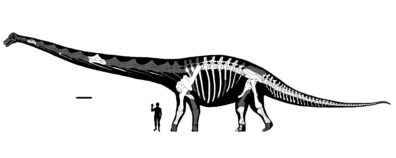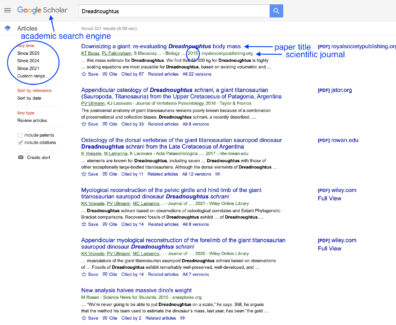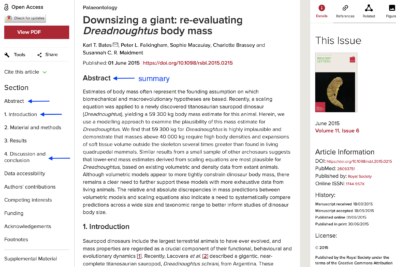Dear Carlos,
Your question almost stumped me. I don’t really have dinosaur scientist pals. So, I turned to an expert on finding answers.
My friend Emily Cukier is a science librarian at Washington State University. She helps students and scientists find information. I asked her what dinosaur is the largest—and how she figures that out.
Cukier told me that I should think hard about my question. Are we looking for the tallest dino? The longest? The heaviest? Those might be different answers.
Then it’s time to ask the internet.
“I’m a librarian, but the first thing I would do is put it into a search engine and see what I get,” Cukier said.
A search engine uses huge, sorted lists of everything on the internet. It makes a new list of articles and sources related to my question.
The first thing you see will probably be an answer from generative artificial intelligence (AI). That’s a computer program. It scrapes lots of information off the internet. Then it writes an answer to the question.
Cukier told me AI is like a parrot. It’s been taught to make words and sentences. But it doesn’t understand what it’s saying. It can’t tell if information is good or bad.
So, I’m going to ignore the AI answer at first. I don’t want to risk getting a wrong answer stuck in my brain at the start of my search. Instead, I scan the search results for reliable sources. I’m looking for museums, universities, encyclopedias or scientists.

Here’s page one of my search results. I consider Wikipedia an encyclopedia because it gets factchecked regularly. But I always check the sources at the bottom of the Wiki article to confirm the information. I also look for notes that say if the article needs updated.
On the first two pages of my search about big dinos, I see articles from two encyclopedias and four museums. I also see a story from an explainer website I’ve used before.
I’m going to focus on these trustworthy sources. Cukier recommends making a list or spreadsheet to track the answers I find. Then I can compare dinosaur heights, lengths and weights.
So, what’s the biggest dino? It turns out it’s hard for scientists to say. We don’t have complete skeletons. We definitely don’t have their squishy, meaty parts.
Scientists measure the bones they find. They use computers to estimate the animal’s size and weight. Sometimes scientists disagree about the estimate. Sometimes the estimate changes when we get new information.


This dinosaur scientist found Dreadnoughtus leg bones in 2005. They used a computer program to figure out how big it probably was—and compared it with a human. Unlike most titanosaurs, we have about half of a Dreadnoughtus skeleton. So, our estimate for its size may be more reliable. ArcaneHalveKnot CC BY-SA 4.0
Right now, we think the largest dinosaurs were a group called sauropods. They were massive veggie eaters. They had strong, stout bodies with four legs and long tails. They had small heads set on long necks. The most famous sauropod is the Brontosaurus.
But the very biggest sauropods were titanosaurs. I see a few titanosaurs listed over and over in my reading: Dreadnoughtus, Argentinosaurus, Patagotitan, Puertasaurus and Sauroposeidon.
To learn more, I could do a new search for each of those dinosaurs. Or I could visit a library and check out books about them.


I’ll probably use an academic search engine like Google Scholar next (left). That will give me a list of scientific papers. Scientific papers start with a summary called an abstract (right). If you want to work with AI, try asking it to summarize an abstract at your reading level. It will only look at the abstract you give it, so you probably won’t get wonky answers. But you still have to check it carefully. You can also try science communication sites for kids like Science News Explores, Science Journal for Kids or Frontiers for Young Minds.
Cukier says that the way we get information is changing really fast. Everyone—even librarians—are working hard to learn the best ways to search.
By flexing your search skills early, the answers you find are sure to be the tricera-tops.
Sincerely,
Dr. Universe